
Kościuszko was a passenger steamship that was built in Scotland in 1915, sailed as a troopship in both World Wars, was an ocean liner between the wars, carried displaced persons after World War II and was scrapped in England in 1950.
SS Chenab was a steamship that was built in England in 1911 and scrapped in Scotland in 1953. For nearly two decades she was part of Nourse Line, which carried Girmityas from India to colonies in the Caribbean and the Pacific. In 1914 she was requisitioned for service in the First World War.

SS Potsdam was a steam ocean liner that was launched in Germany in 1899 for Holland America Line. In 1915 Swedish American Line acquired her and renamed her Stockholm.
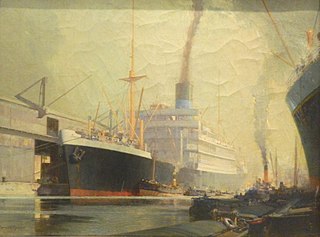
SS Sarpedon was a UK steam turbine passenger and refrigerated cargo liner launched in 1923. She was the fourth of six ships to bear the name.
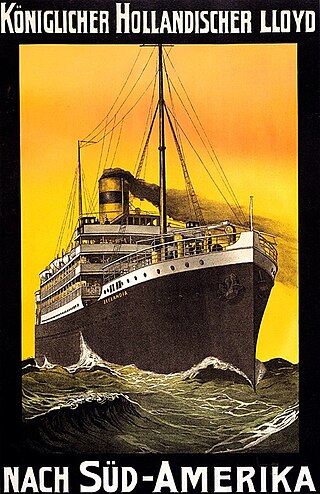
USS Zeelandia was an ocean liner that was built in Scotland in 1910 and scrapped in the Netherlands in 1936. She was the largest ship in the Koninklijke Hollandsche Lloyd (KHL) fleet from 1910 until the liners Gelria and Tubantia were completed in 1913 and 1914. She was USS Zeelandia from April 1918 until October 1919, when she was a United States Navy troopship.
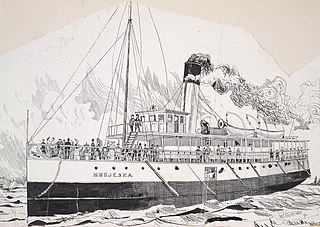
SS Manitoulin was a Great Lakes passenger steamship. She was built in 1889 as Modjeska, and renamed Manitoulin in 1927 after a major refit. She was laid up in 1949 and scrapped in 1953.
Elisabethville was an 8,851 GRT ocean liner which was built in 1921 for Compagnie Belge Maritime du Congo. In 1930 the company became Compagnie Maritime Belge. She served the Antwerp - Matadi route, connecting Belgium to Belgian Congo.
Arpha was a 602 GRT passenger ferry built in 1900 as Canterbury for the South Eastern and Chatham Railway. She passed to the Southern Railway on 1 January 1923. She was sold to W E Guinness in 1926 and renamed Arpha. In 1938 she was sold to Sark Motorships Ltd, only to be requisitioned by the Royal Navy in 1939. Postwar, she was sold to Compania Shell de Venezuela and renamed Coriano. After a further change of ownership she was scrapped in 1955.

SS Polar Chief was a merchant steamship that was built in England in 1897 and scrapped in Scotland in 1952. In her 55-year career she had previously been called Montcalm, RFA Crenella, Crenella, Rey Alfonso, Anglo-Norse and Empire Chief. Early in the First World War she spent eight months pretending to be the battleship HMS Audacious.
Ramón Alonso R. was a merchant steamship that was built in Scotland in 1898 and scrapped in Spain in 1959. Her original name was Montclair. She was renamed José Gallart in 1901, Balmes in 1911 and Ramón Alonso R. in 1929. Her first owner was the British Elder Dempster Lines, but she spent most of her career with a succession of Spanish owners. She was built as a transatlantic ocean liner with some cargo capacity, but in 1927 she was refitted as a cargo ship. In 1913, when she was called Balmes, the ship survived a serious cargo fire in mid-Atlantic.

SS Munich was a North Sea passenger ferry that was built in Scotland in 1908 for the Great Eastern Railway (GER). In the 1923 railway grouping she passed to the new London and North Eastern Railway (LNER). She was scrapped in England in 1950.

Lamport and Holt was a UK merchant shipping line. It was founded as a partnership in 1845, reconstituted as a limited company in 1911 and ceased trading in 1991.

SS Vauban was a 1912 steam ocean liner operated by Lamport and Holt Line and used on its service between New York and the River Plate. She was named after the French military engineer Sébastien Le Prestre de Vauban (1633–1707). She was a troop ship in the First World War, resumed passenger service until 1930 and was scrapped in 1932.
Anselm was a cargo and passenger steamship built by Workman, Clark and Company in Belfast for the Booth Line service between Liverpool and the Amazon ports in Brazil. It was the second of four Booth Line ships to be named after Saint Anselm.
SS Ruahine was a UK-built ocean liner and refrigerated cargo ship. She was launched in 1909 in Scotland for the New Zealand Shipping Company, who operated her in scheduled service between Britain and New Zealand. She survived both World wars.

SS Grampian was a transatlantic ocean liner that was built in Scotland in 1907 and scrapped in the Netherlands in 1925. She was operated originally by Allan Line, and later by Canadian Pacific Steamships. In the First World War she remained in commercial service but carried Canadian troops. In 1919 she survived a collision with an iceberg. In 1921 she was gutted by fire while being refitted. The refit was abandoned, and in 1925–26 she was scrapped.
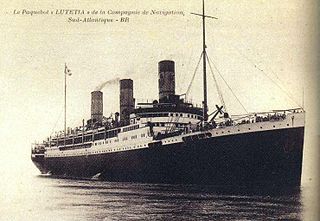
SS Lutetia was a steam ocean liner of the Compagnie de Navigation Sud-Atlantique. She was completed in 1913. Lutetia was the Roman city on the site of what is now Paris.
SS Vandyck was a 1911 steam ocean liner operated by Lamport and Holt Line and used on its service between New York and the River Plate. The German cruiser Karlsruhe sank her in 1914.
SS Huntingdon was a refrigerated steam cargo liner that was built in Germany in 1920 as Münsterland. The United Kingdom took her as war reparations and sold her to the Federal Steam Navigation Company, who renamed her Huntingdon. She operated between Britain and Australasia until 1941, when an Italian submarine sank her in the Atlantic Ocean.
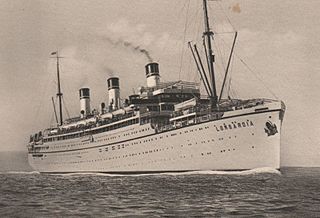
SS Lombardia was one of a pair of transatlantic steam ocean liners that were launched in 1914 in Germany for the Hamburg America Line (HAPAG), sold to a Dutch shipping line in 1916, and seized by the United States as World War I reparations in 1922. United American Lines (UAL) operated her until 1926, when HAPAG bought her back.












